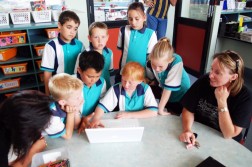The biggest ever world’s fair closed the turnstiles over the weekend. With a few hours to spare in Shanghai last month, I went along to see what all the fuss was about.
Popping up out of the Yaohua Road subway, I navigate my way through the scalpers, ticket queues, security screening and finally the turnstile, past dozens of idle volunteers.
The city and the event make a great match. It has been noted elsewhere that Shanghai and Expo are about the same vintage. London’s Crystal Palace hosted the first Expo in 1851, which exhibited cutting-edge steam engine developments, steel-making techniques and bridge designs. Shanghai’s importance as a global trading city can be traced back to the Treaty of Nanking in 1842. Both are products of a 19th century worldview which is highly optimistic about international industry and trade.
But who cares about history? Shanghai is ready to run up its flag to be the next global capital. Beijing had its Olympics, and now it’s Shanghai’s turn. More than AU$48billion was spent in preparation for this more than Beijing spent in the leadup to the 2008 Olympics.
With a theme of better City, Better Life, it is all very "eco", obviously. This is billed as the first low-carbon expo. Rubbish is sorted into friendly bins. Every building lists its credentials for energy usage and decommissioning plans. What was demolished to build this? Oh, just a few entire neighbourhoods. By its own count, Expo displaced 18,000 families and 270 factories, including the Jiang Nan Shipyard, which employed 10,000 workers. But you can’t argue with progress. According to Amnesty International, housing activists were put under heavy surveillance, many detained and beaten, while the site was being built.
To get into the China pavilion you have to get a special advance ticket, then queue for hours, then go up a good deal of stairs as if entering a temple. I decide to skip it. Around the side, Macau, Hong Kong and Taiwan hunker like granny-flat pavilions, diminutive satellites to China’s awesomeness. Or perhaps they are grateful dependents, sharing China’s taproot of development? Hang on, should Taiwan really be under China’s wing? This kind of heavy-handed but ambiguous architectural symbolism is everywhere.
In May, then Trade Minister Simon Crean came to Expo and launched the new national brand, Australia Unlimited. Heard of it? Me neither.
Crean said the brand shows "Australia is not just a destination for tourism, it’s also a place to do business, to invest, to build global and regional headquarters, to expand trade opportunities and forge partnerships… it’s demonstrating the strength of our creativity, our innovation, our welcoming nature, our inclusive nature." That innovation includes clean coal and gas technologies with which Australia hopes to build its resource profile alongside China’s growth.
This rebrand will cost $20 million over four years. Many countries now see such expenditure as necessary. Nation branding, it turns out, is an entire school of political theory and marketing with its own journal, as well as an employment scheme for companies like M&C Saatchi (who got our contract), or Saatchi&Saatchi, who recently gave Kosovo an AU$8.5 million makeover. M&C Saatchi also gave us Where the Bloody Hell Are You, a campaign which showed how involved Australians were in our representation overseas.
It’s not entirely a shallow marketing exercise. Even the self-described founder of nation branding, consultant Simon Anholt, sees it as a mistake to invest solely in image management, rather than enact actual change.
Anholt was recently in Australia, calling it a dumb blonde. In a recent article in The Age, he said, "Rather than waste time fiddling around with promotional campaigns, what Australia needs to do is to invest in the sectors which demonstrate its seriousness and its capability" — including education and culture.
But it seems that the opportunity to present contemporary Australian culture to the world at Expo was largely missed in favour of an insubstantial corporate presentation which offers plenty of photo montages but little in the way of substance.
The website for the Australia pavilion, a big rusty curve with bulging orange veins, says the weathered steel structure is supposed to "acknowledge Australia’s ancient landscape while demonstrating the sophistication of modern urban design in Australia," but it looks like a weird shed beside the friendly old palace structures of Thailand and Cambodia, and positively menacing behind New Zealand’s glass-backed plant stand.
Outside Australia there is a bloke with his hand in a koala puppet, patiently entertaining a group of Chinese children. "Nah, pretty much they just eat gum leaves," he says, squatting to their level.
Inside, there’s a spiral walkway, a carpeted ramp which takes you up the outer curve of the building, through a short representation of Australian history. The first part is a walk-through display of mimih poles from Maningrida, hollow logs painted with ceremonial designs which form a silent guard. The crowd presses through.
Then there’s a rubbery diorama of Captain Cook, the gold rushes, a bit of immigration, and a handful of facts about Australia which are of interest to the Chinese, like our wacky population density. Contemporary Indigenous politics is not entirely absent — a plasticine Cathy Freeman doll stands on the Opera House. And then there’s a poster composed of pictures of representatives of the Stolen Generations wearing t-shirts which say Thanks, and smiling gratefully at Kevin Rudd, a man who’s not past his use-by date in China.
At the top of the spiral there’s a crush before we all spill down into the theatre for the main feature. At centre stage is a diorama of a giant sandpit. Three spinning screens pop up from the ground around it and three animated kids give us soundbites around the "better city" theme. There’s a white kid, a black kid and an Asian kid. They play happily together and have the kind of conversation real children would never have about the kind of opportunities they want when they grow up.
Australia is a brand intensely marketed in Asia, with three main selling points: tourism, natural resources, and education. All of these are present here, in a package which manages to be simultaneously aspirational and unambitious. The pavilion is suffering from unclear branding.
Indeed, the Australia pavilion presents an image of a country in eternal infancy, playing in the sandpit while the city soars around it. I can’t help wondering if this childishness is a submissive trade strategy — all this future is making me paranoid. It is more likely that in pitching itself to be accessible to mainstream Chinese audiences the pavilion has erred on the side of caution and cliché.
Perhaps Expo is not the place for complex cultural exchanges. There are initiatives like Imagine Australia, a year of Australian culture in China, which pad out this kind of soft diplomacy/cultural branding by employing actual artists to do creative work. Don’t feel special — 2010 is also a Year of Friendship between China and Indonesia and a six-month Festival of India has just ended. My own residency here is arguably part of the same strategy — it is partly funded by DFaT’s Australia-China Council (not to be confused with the Australia-China Business Council, who are sponsors of the Expo pavilion).
Despite a $20 million dollar investment in Australia Unlimited and the $83 million spent on our Expo pavilion ($61 million Federal and $22 million from States and sponsors), the site presents a country that is multicultural but unsophisticated. There’s hardly an innovation in sight — not even the clean coal Crean was so keen on.
The punter’s Expo which I experienced is only a part of the action, however; the whole show is seen as an investment. Our pavilion and the national brand will help attract business to our innovative, creative, koala-puppet-waggling nation. The site has hosted plenty of corporate schmoozefests for businesspeople and trade ministers. But it does seem, to this visitor at least, an expensive folly. Expo may not be able to escape its beginnings as a Victorian extravagance. If we must show off, give us these expensive battles for brand dominance over a world war any day. If nothing else, Expo gives the Chinese media plenty of uncontroversial stories to cover.
I leave the rusty shed, resisting the temptation of a cold Cooper’s Ale, as dusk is falling. On my way back to the subway I pass a glowing blue sign offering directions for "Regular Visitors to Urban Planet". The future is beckoning. I head for the exit.
Jennifer Mills is in China on an Asialink Arts residency.
If you liked this article help keep New Matilda alive by pledging your support.
Donate To New Matilda
New Matilda is a small, independent media outlet. We survive through reader contributions, and never losing a lawsuit. If you got something from this article, giving something back helps us to continue speaking truth to power. Every little bit counts.



